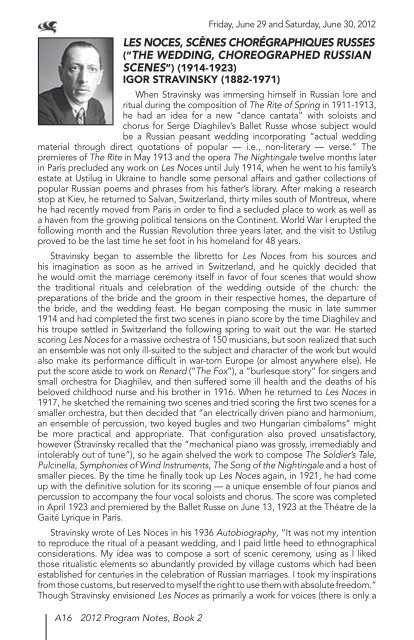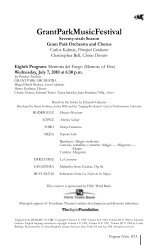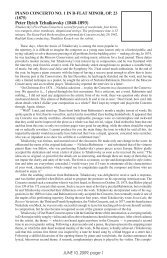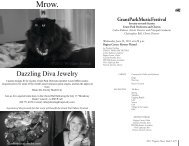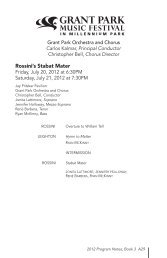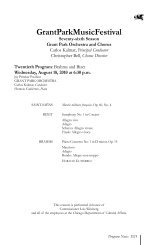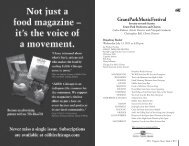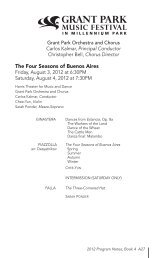Golden Anniversary Choral Spectacular - The Grant Park Music ...
Golden Anniversary Choral Spectacular - The Grant Park Music ...
Golden Anniversary Choral Spectacular - The Grant Park Music ...
You also want an ePaper? Increase the reach of your titles
YUMPU automatically turns print PDFs into web optimized ePapers that Google loves.
LES NocES, ScèNES choréGraphIquES ruSSES<br />
(“ThE WEddING, chorEoGraphEd ruSSIaN<br />
ScENES”) (1914-1923)<br />
iGOr STrAVinSKY (1882-1971)<br />
When Stravinsky was immersing himself in Russian lore and<br />
ritual during the composition of <strong>The</strong> Rite of Spring in 1911-1913,<br />
he had an idea for a new “dance cantata” with soloists and<br />
chorus for Serge Diaghilev’s Ballet Russe whose subject would<br />
be a Russian peasant wedding incorporating “actual wedding<br />
material through direct quotations of popular — i.e., non-literary — verse.” <strong>The</strong><br />
premieres of <strong>The</strong> Rite in May 1913 and the opera <strong>The</strong> Nightingale twelve months later<br />
in Paris precluded any work on Les Noces until July 1914, when he went to his family’s<br />
estate at Ustilug in Ukraine to handle some personal affairs and gather collections of<br />
popular Russian poems and phrases from his father’s library. After making a research<br />
stop at Kiev, he returned to Salvan, Switzerland, thirty miles south of Montreux, where<br />
he had recently moved from Paris in order to find a secluded place to work as well as<br />
a haven from the growing political tensions on the Continent. World War I erupted the<br />
following month and the Russian Revolution three years later, and the visit to Ustilug<br />
proved to be the last time he set foot in his homeland for 48 years.<br />
Stravinsky began to assemble the libretto for Les Noces from his sources and<br />
his imagination as soon as he arrived in Switzerland, and he quickly decided that<br />
he would omit the marriage ceremony itself in favor of four scenes that would show<br />
the traditional rituals and celebration of the wedding outside of the church: the<br />
preparations of the bride and the groom in their respective homes, the departure of<br />
the bride, and the wedding feast. He began composing the music in late summer<br />
1914 and had completed the first two scenes in piano score by the time Diaghilev and<br />
his troupe settled in Switzerland the following spring to wait out the war. He started<br />
scoring Les Noces for a massive orchestra of 150 musicians, but soon realized that such<br />
an ensemble was not only ill-suited to the subject and character of the work but would<br />
also make its performance difficult in war-torn Europe (or almost anywhere else). He<br />
put the score aside to work on Renard (“<strong>The</strong> Fox”), a “burlesque story” for singers and<br />
small orchestra for Diaghilev, and then suffered some ill health and the deaths of his<br />
beloved childhood nurse and his brother in 1916. When he returned to Les Noces in<br />
1917, he sketched the remaining two scenes and tried scoring the first two scenes for a<br />
smaller orchestra, but then decided that “an electrically driven piano and harmonium,<br />
an ensemble of percussion, two keyed bugles and two Hungarian cimbaloms” might<br />
be more practical and appropriate. That configuration also proved unsatisfactory,<br />
however (Stravinsky recalled that the “mechanical piano was grossly, irremediably and<br />
intolerably out of tune”), so he again shelved the work to compose <strong>The</strong> Soldier’s Tale,<br />
Pulcinella, Symphonies of Wind Instruments, <strong>The</strong> Song of the Nightingale and a host of<br />
smaller pieces. By the time he finally took up Les Noces again, in 1921, he had come<br />
up with the definitive solution for its scoring — a unique ensemble of four pianos and<br />
percussion to accompany the four vocal soloists and chorus. <strong>The</strong> score was completed<br />
in April 1923 and premiered by the Ballet Russe on June 13, 1923 at the Théatre de la<br />
Gaité Lyrique in Paris.<br />
Stravinsky wrote of Les Noces in his 1936 Autobiography, “It was not my intention<br />
to reproduce the ritual of a peasant wedding, and I paid little heed to ethnographical<br />
considerations. My idea was to compose a sort of scenic ceremony, using as I liked<br />
those ritualistic elements so abundantly provided by village customs which had been<br />
established for centuries in the celebration of Russian marriages. I took my inspirations<br />
from those customs, but reserved to myself the right to use them with absolute freedom.”<br />
Though Stravinsky envisioned Les Noces as primarily a work for voices (there is only a<br />
A16 2012 Program Notes, Book 2<br />
Friday, June 29 and Saturday, June 30, 2012


